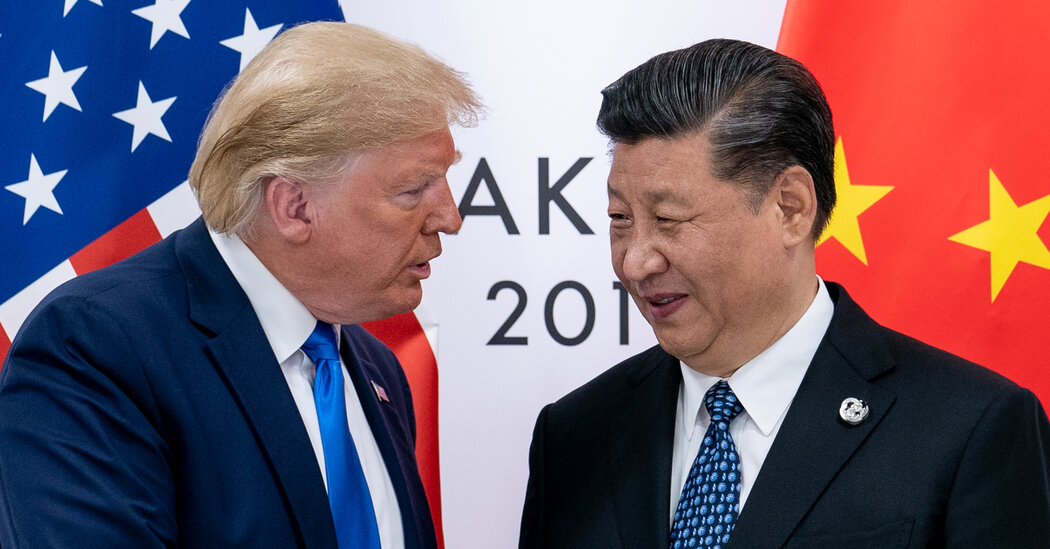When Air Force One lands on Sunday in Malaysia, President Trump will begin a tour that will bring him face to face with China’s top leader, Xi Jinping, as well as a region that has been increasingly reshaped by the competition between Beijing and Washington.
In this new kind of superpower rivalry, he and Mr. Xi are offering contrasting visions for how the world should be ordered, with consequences for chip factories in South Korea, factory floors in Vietnam, the contested waters of the South China Sea and the status of the self-governed island of Taiwan.
Unlike the Cold War, the battlegrounds for power and influence are centered not only on troops and warships, but also on supply chains, ports and data centers. Governments across Asia are increasingly being pressured to pick sides. Countries caught in the middle, like Thailand, Singapore and Indonesia, must weigh how to benefit from the competition without being held hostage to it.
“Countries in the region don’t want to be seen as just pawns that the U.S. and P.R.C. can pass over as the two cut deals above their heads,” said Ja Ian Chong, a professor of political science at the National University of Singapore, using the abbreviation for the People’s Republic of China.
“They want agency and would much rather have Washington and Beijing woo them so that they can play both powers off one another,” he added.
That might have been easier in the past when the United States was more engaged with Asia. When an American president visited, it would often be a way to reassure the United States’ friends in the region that Washington had their backs when it came to an increasingly assertive China.
But as Mr. Trump arrives on Sunday, America’s commitments to its allies and partners remain an open question, strained by resentment over tariffs and uncertainty over the future of U.S. troop deployments.
Beijing has sought to take advantage of that uncertainty by offering trade deals and investments to its neighbors, while staking a wider claim to the region as the only superpower willing and able to confront the Trump administration. It has warned the region of the consequences of joining Washington in restricting trade with China.
“To seek one’s own temporary selfish interests at the expense of others’ interests is to ask a tiger for its skin,” the Commerce Ministry in Beijing said this year, using an idiomatic expression to imply that trying to appease the Trump administration was both dangerous and futile.
It will be difficult for Asian governments — even U.S. allies like South Korea and Japan — not to feel like bystanders when Mr. Trump and Mr. Xi meet next week on the sidelines of the Asia-Pacific Economic Cooperation summit in South Korea. The global economy hangs in the balance as the two leaders hold talks that could either prompt or prevent another full-blown trade war.
Mr. Trump wants Mr. Xi to roll back China’s new export controls on rare earths, restart purchases of U.S. soybeans and do more to crack down on Chinese-made chemicals used to make the highly addictive opioid fentanyl. Most important, experts say, he wants to come away looking like he scored a deal with Mr. Xi, bolstering his image as a strongman.
On the other side is Mr. Xi, who wants Mr. Trump to drop his tariffs on Chinese goods, ease access to U.S. technology like semiconductors and loosen restrictions on Chinese investments in the United States, analysts said. The icing on the cake for Mr. Xi would be if Mr. Trump signaled he was open to reducing Washington’s support for Taiwan.
Mr. Xi is likely going into the talks feeling that China has the stronger hand. New export rules on rare earths, which are needed for virtually every modern-day technology, have given him powerful leverage. America is still years away from finding suitable alternatives.
But the export controls also threaten to undermine Beijing’s bid to court other countries, which has included pledging to do more to reduce emissions, and promises to upgrade a free-trade agreement with Southeast Asian nations.
“They defend multilateralism. They say they are not a hegemon, that they’re not a bully,” said David Meale, the head of Eurasia Group’s China practice and former U.S. deputy chief of mission in Beijing. “I don’t think they quite understand what they did to the world,” he said, referring to the rare earth rules.
When Mr. Trump arrives in Southeast Asia, however, it will also be America’s reputation that will be scrutinized. Countries are still reeling from his sweeping tariffs, which hit their export-dependent economies hard.
Skepticism of the United States has also grown over the Trump administration’s sudden withdrawal of foreign aid, and over Washington’s support for Israel’s assault on Gaza. Mr. Trump is so unpopular in Malaysia, a predominantly Muslim nation, that Prime Minister Anwar Ibrahim even felt compelled to clarify that the invitation to the American president was made on behalf of the 10-member Association of Southeast Asian Nations and not a bilateral overture.
That skepticism is compounded by unease over the growing feud between the United States and China and what it could mean for a region that has long shied away from choosing sides.
Lynn Kuok, a Southeast Asia expert at the Brookings Institution, said that with the uncertainty surrounding the United States, many Southeast Asian countries were trying to deepen ties with Gulf nations and Europe.
“That said, given China’s proximity and sustained engagement, the region could tilt further toward China, by design or necessity,” she said. “Beijing’s longstanding economic, strategic and diplomatic engagement with the region both bilaterally and multilaterally positions it to gain the most from any vacuum left by Washington.”
China will no doubt be a major topic when Mr. Trump goes to Japan, where he will meet Sanae Takaichi, who this past week was elected as the country’s prime minister, the first woman to serve in that role.
Ms. Takaichi suggested during her leadership bid that she could take a tougher approach in dealing with the Trump administration. But she has recently struck a moderate tone, pledging to work to preserve a trade agreement signed by her predecessor in July.
Ms. Takaichi is expected to make building a rapport with Mr. Trump a priority, tapping into their shared admiration for Shinzo Abe, the former prime minister who was assassinated in 2022, and who was a mentor to Ms. Takaichi.
She is also likely to raise the concerns about China’s growing military and economic power in Asia.
Similar concerns are being felt in South Korea, a staunch ally of the United States that now finds itself increasingly caught between its dependence on American security and its reliance on trade with China. South Korea hopes that a meeting between Mr. Trump and Mr. Xi, which is expected on Thursday, will help ease their tension so South Korea can have more breathing room.
During a visit to Washington in August, President Lee Jae Myung acknowledged that it was getting harder to strike a balance given the intensifying competition between the two giants, saying, “it’s no longer possible to maintain that kind of logic.”
Reporting was contributed by Choe Sang-Hun from Seoul, Javier C. Hernández from Tokyo, Sui-Lee Wee from Kuala Lumpur, Malaysia, and Lily Kuo from Taipei, Taiwan.
David Pierson covers Chinese foreign policy and China’s economic and cultural engagement with the world. He has been a journalist for more than two decades.
The post Asia, Caught in the Middle, Faces Trump and Xi’s Tug of War appeared first on New York Times.




